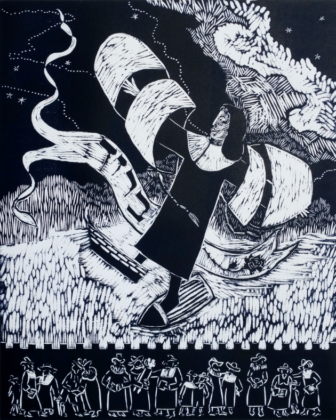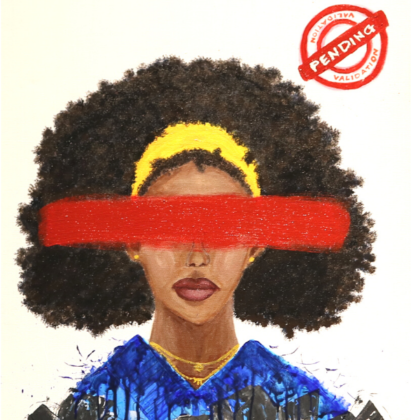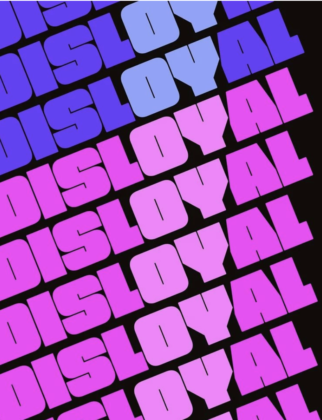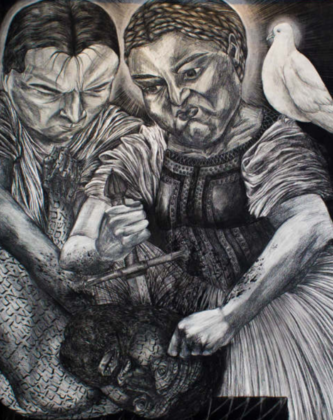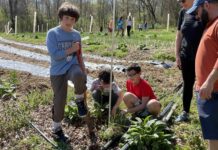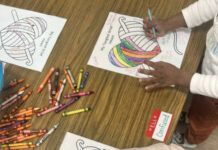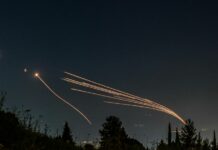Who feels safe anymore? Can you “circle the wagons,” while keeping open arms? And how has Judaism’s call to “build a fence around the Torah” served to protect and preserve its teachings and culture, while also marginalizing some Jews and, at times, the wider community?
These and other questions of “safety and unsafety,” are considered and explored in the Jewish Museum of Maryland’s latest exhibit, “A Fence Around the Torah: Safety and Unsafety in Jewish Life,” running through Feb. 11 at the museum’s Herbert Bearman Campus, located at 15 Lloyd St. in Baltimore.
When museum staff, headed by Executive Director Sol Davis, saw an opportunity to fill an open nine-month slot in its Feldman Gallery’s schedule, they decided to use the museum’s substantial voice to look deeply into the cultural effects of the pandemic, while opening its arms to the community.
“We had two primary goals,” Davis said. “One, to experiment with different museum practices, in this case community-based curatorial practices. And two, to engage demographics of people who may have had little or no prior engagement with the JMM.”
The museum hired Liora Ostroff, a Baltimore-based painter and Maryland Institute College of Art alum, as curator-in-residence to lead the development of the exhibit, which she described as demonstrating art “as integral to informing and transforming Jewish community in two ways.”
“One: art is essential to engaging with our history. Art allows us to reinvestigate cultural loss, reframe cultural narratives and illuminate connections between past and present problems,” Ostroff said in an email. “One artist-collective in this exhibit describes the complexity of how trauma, politics and safety shape cultural expression. In their multimedia installation, ‘I mean…How Do You Define Safety?’ Hannah Aliza Goldman, Coral Cohen, Arielle Tonkin and Annabel Rabiyah activate an intergenerational, multisensory dialogue about what it means to be safe as an Arab Jew and within a cultural identity that has been politicized, erased and ruptured by history.
“Two: we need art of all forms to imagine our future,” she added.
As examples, she pointed to Jewish artists Nicki Green and Arielle Tonkin, whose works “reassess ritual objects for present times and complex identities,” Ostroff said. According to statements from each of the artists, Green’s ceramic work “carv[es] out space for trans Jews,” while Tonkin explores a variety of media to imagine “how some Arab Jews in the diaspora are reimagining Jewish ritual to connect to parts of our lineage that weren’t transmitted through Jewish institutional life in the U.S.”
A curatorial panel that included the Council of American Jewish Museums, New Jewish Culture Fellowship, Jewish Theological Seminary, LABA: Laboratory for Jewish Culture and the Jews of Color Mishpacha Project selected the exhibit’s pieces by 15 artists from across the nation. As the group made its choices, themes emerged from the artists’ interpretations of questions posed about safety, unsafety and exclusion.
According to the JMM’s website, those themes are “personal reflections on queer life and Judaism, racial justice in Jewish spaces, cultural dialogues and political dissent, mythological narratives around unsafety, and dreams for inclusion and solidarity coming from within Jewish institutions and the organized Jewish community.” The themes are realized through works employing video, sculpture, installation, painting, textile, poster art, poetry and other expressions.
“The exhibit’s title is drawn from Pirkei Avot, which instructs Jews to make a fence around the Torah,” Davis said. “We have taken that line as a point of departure for a project that is about locating the fences and boundaries that Jewish communities have created around themselves for protection and to sustain Jewish life, and to consider the ways those fences serve our communities. And also how they might be reconfigured in places where they are not serving to nourish and fortify us.”
Davis added that, personally, his ideas and feelings about safety and unsafety “are quite fluid,” including what he’s feeling deeply lately: “that our safety is tied to our relationships and solidarity with other communities, particularly other historically marginalized communities.”
In an effort to engage that wider community, the museum held a series of conversation events at the museum, addressing the concepts of safety and unsafety. Speakers included Rabbi Jessy Dressin on “Imagining Jewish Futures;” Harriette Wimms on “Queer Life and Judaism;” and Tikvah Womack on “Safety in Orthodox Life.”
Davis hopes visitors leave the exhibit thinking in new ways about the central questions the exhibit poses: “What makes you feel safe? When does what makes you feel safe make others feel less safe?
“We believe that this exhibit holds the potential to shift and expand communal conversations about safety, while increasing people’s understanding about the precarity that some members of the community experience and others are not aware of,” he added.


